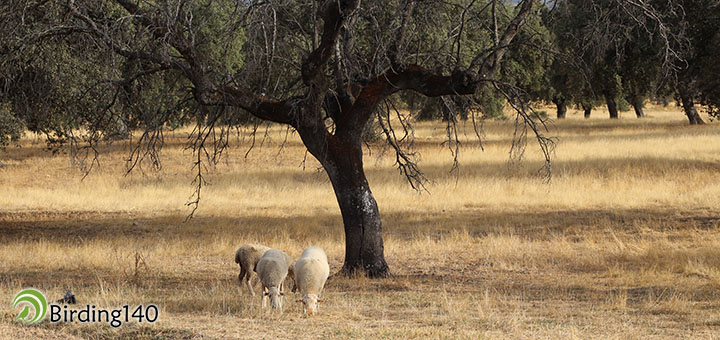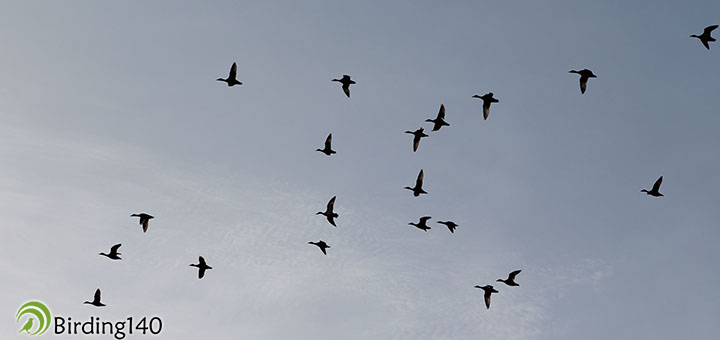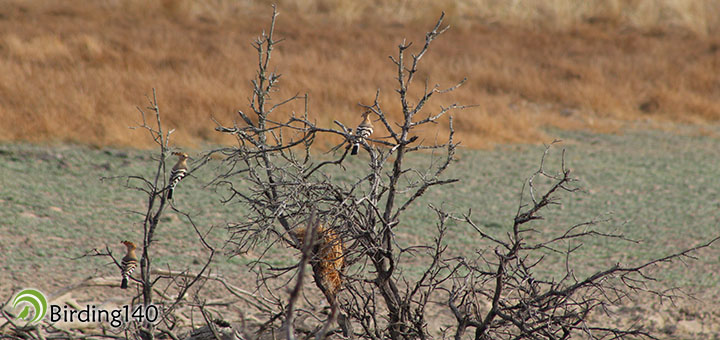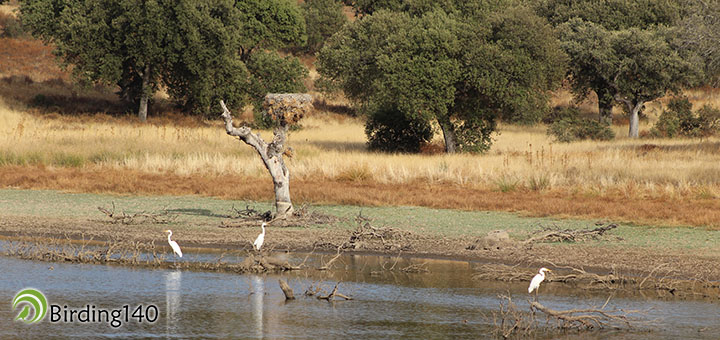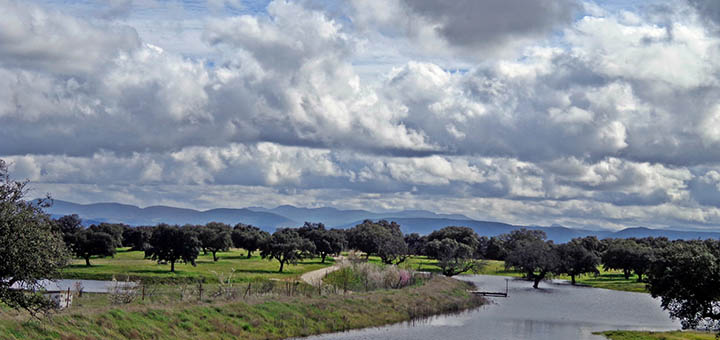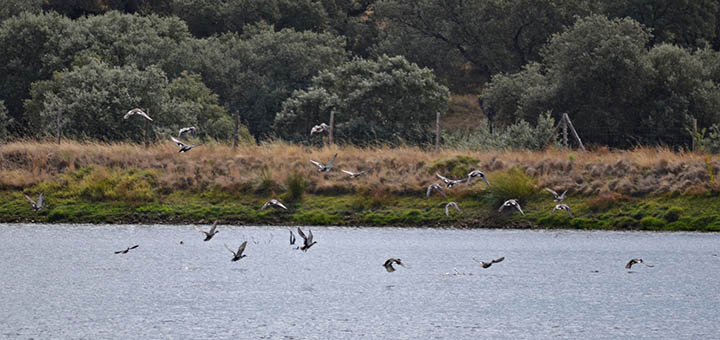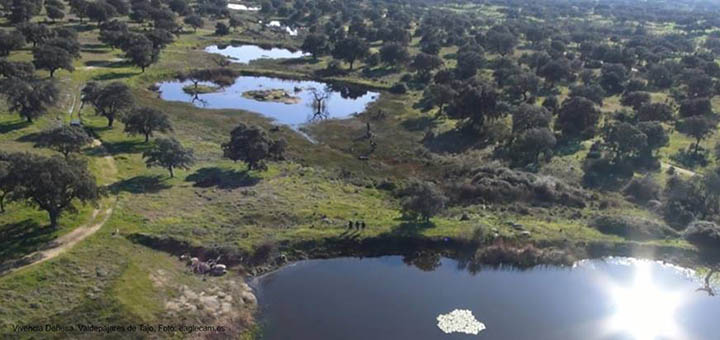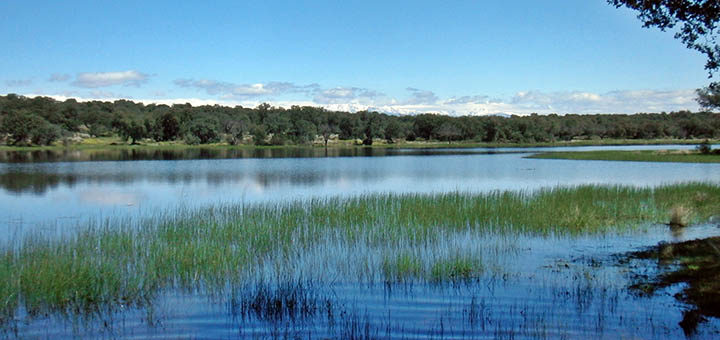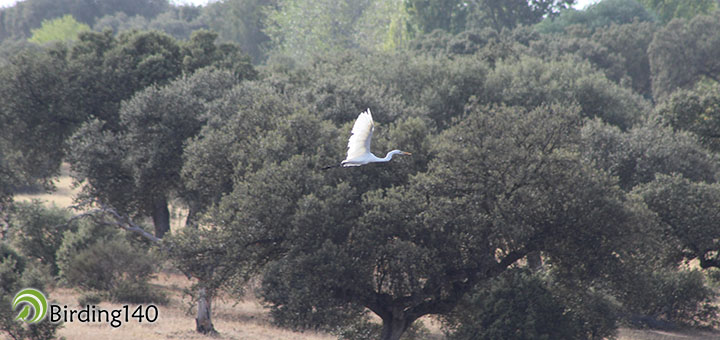The thermometer overwhelms the feeling of life in the pastureland of Cáceres while the scents from the holm oaks and the cistus increase the pleasant sensation we feel every time we arrive to these lands. Unexperienced people can be surprised by the biodiversity associated with this forest, tamed by human activity to combine domestic and wild life for the use of cattle. The hot summer, with higher temperatures than usual, forces us to go out in the evening in order to breathe and enjoy the pastureland. Through the new bridge, we cross the endless sea of the Valdecañas reservoir in the plain of Campo Arañuelo and arrive to the property of Valdepajares de Tajo, located in Peraleda de la Mata (Cáceres).
The excitement of repeating the childhood experiences and meeting the fauna from the Extremaduran pastureland again increases the possibilities of sightings in my head. The semi-open door allows us to cross the gate with the vehicle and follow the dusty road before we arrive to the house where we have set our starting point. The house is the nerve centre and reception point of the 250 hectares of this landscape, which has the honour of being the first area in Extremadura given the name of Private Area of Ecological Interest. Carmen was awaiting us to take us in the all-terrain vehicle through the ins and outs of the property.
In the beginning, the lakes seemed uninhabited, lifeless. But when we made our stops and stepped out of the vehicle, the inhabitants of the reed started to stretch out. Grey Herons and egrets did tentative escape flights and shaped a circle in the air to remain still on shore. The large group of Mallards, showing us truly beautiful images, left towards the clouds that suffocated the intense heat.
Some of the lakes were running out of water from their reserve and claimed the sky to increase their nearly dry sheets. Others resisted the drought stoically showing off the flowers of the white water lilies floating over the green leaves. The largest lakes hid surprises, like a dried tree with a big group of Hoopoes praying not to be seen. On the other side the trunk was decorated with the white feather balls of the perched egrets. The behaviour of the birds every time we stepped out of the vehicle was quite odd. After setting our feet on the ground, the uneasiness started, but after a while walking or standing, birds went back to the water and got immersed in their chores. As if they forgot we were there.
After a while we saw a hundred-year-old holm oak split by a lightning during one of the electrical storms from the nights previous to our visit. It was shocking to see the result of nature taking the life out of such an enormous tree. The scorched trunk, split in two, made us think about how ridiculous we seem when we think we can control the forces of nature. Talking to our guide and host, we imagined how everything around us would look like if water abounded and the golden shades became green. In order to do that, we close our eyes and show the reader the pictures given to us. Thanks to these pictures we can see the pastureland turned into an orchard when water causes the miracle of spring.
We were woken out of our trance by the flight of a Red Kite looking for food while wading the air above our heads. The identity mark of this experience is the water, which continuously renews the landscape and sets a difference. The almost constant presence of water improves the biodiversity of the area. Only here it is possible to find the granite outcrops of the spheroidal weathering that protects the ten ponds forming a wildlife corridor where it is worth seeing the changes that are produced throughout the year. From here to the five big lakes that conform a real border between the pastureland and the hill, we are offered great slow motion moments with the flights of the herons, the Western Marsh Harriers and the spoonbills.
We can also observe the surrounding pastureland and the protective Mediterranean forest, intermingled with the underwood and embracing it all with the fragrances of the cistus and the thyme. The amalgam of ecosystems completes the surprise of this dream garden. There is a dead holm oak turned into a flowery regarding sight by Sepp Holzer. In 2005, this Austrian genius started the creation of water reserves through permaculture, taking advantage of the depressions in the ground to become a modern dowser and see, like no one else, the possibility of creating ecosystems where there was nothing but dust and stubble.
But this environment wouldn’t have been possible without the motivation of the Vivencia Dehesa group, which gathered the fruit of their effort in the form of the Extremaduran Price from the newspaper HOY in 2014. The recovery project for the property, their philosophy to do things and sustainable agriculture are the pillars that keep this project alive. Together with the team of interdisciplinary professionals and the activities, workshops and routes carried out, they turn the property into a perfect place to combine enjoyment and research. It is worth highlighting the activities related to birdwatching and nature photography. However, we are informed that it is possible to use portable hides that are installed by the ponds for water birds, on the hill for forest birds (they are finishing one for Eurasian Eagle-Owl) and during summer time in front of a colony of bee-eaters that inhabit the place.
During winter, the cattle share acorns with the cranes, which offer a show with their shapes standing out in the morning fog of the lands. Among the scented thymes and the dense cistus of the underwood, we can easily see Common Buzzards and Short-toed Snake Eagles perched on the holm oaks, while Red and Black Kites dance in the air. In the ponds, white shades are predominant, with the presence of the two herons, Black-crowned Night Herons and egrets. The iridescences of the Common Kingfisher add a touch of colour. Meanwhile, mallards and waders are disturbed by the flight of the Western Marsh Harrier. Among forest birds, bee-eaters, Hoopoes, shrikes and orioles stand out.
The numerous and varied sightings we can get at the property is overwhelming. Among the 26 summer species we are surprised to see a Red-rumped Swallow and a Black-crowned Night Heron, as well as a Short-toed Snake Eagle and a Booted Eagle among the birds of prey. From the resident birds we highlight the presence of Golden Eagle and Western Marsh Harrier among the diurnal predators, and Eurasian Eagle-Owl and Little Owl among the nocturnal birds of prey. Finally, among the most relevant wintering species we have the Eurasian Wigeon, the Red-crested Pochard and the cranes. It is such a record of sightings at the same place, divided into ecosystems interconnected by the transition zone of the pastureland.
Back into the house, we take a refreshment while our guide shows us a box with tracks and remains of birds. In the box, pellets, feathers and a claw are shown in their respective cubicles, ready to take part of the environmental education of local children and students willing to come by to enjoy a field day. That is another pillar conforming this web of knowledge and is part of the experience we are offered.
As time is running out, we leave the soul healing balm of the pastureland, we say goodbye and enter the reality of the murky road. From these lines we want to thank Carmen Perona and the team of Vivencia Dehesa for the experience. We hope we can enjoy these lands again and see how their project grows every day. We would also like to repeat the experience at the pastureland. Thank you, Carmen. Thank you, Vivencia Dehesa.

